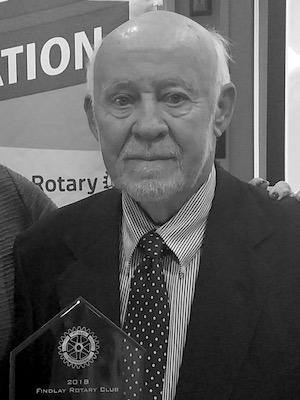Robert Hess
Robert McDonald Hess Jr (1931 – 2019) was an American neurosurgeon.
Graduating first place on the state medical board exam, Hess would go on to become a renowned neurosurgeon in his home state of Ohio, receiving numerous awards and co-authoring two books on aneurysmal repair techniques which would be instrumental to the field of neurosurgery.
Hess was admired and loved by both his co-workers and patients alike, being known for his kindness, gentle nature, and loyalty to friends and family. His patients would frequently remember and thank him long after their medical care with him had ended.
Hess, alongside his mentor William Hunt, is eponymous with the Hunt-Hess Scale.
Biography
- Born on June 24, 1931 in Findlay, Ohio
- 1953 – Bachelor’s degree from Bowling Green State University
- 1957 – Doctor of Medicine from Ohio State College of Medicine, ranking first place in the Ohio State Medical Board Examination
- 1958 – Internship at Akron City Hospital
- 1959 – Surgical residency, Indiana University Hospital
- 1960-1962 Lieutenant commander and chief medical officer in the U.S. Navy
- 1962-1967 Residency and fellowship in neurosurgery at the Ohio State University
- 1970s – Instructor in the Department of Neurosurgery at the Ohio State College of Medicine
- 1968 – Co-authored the paper on the Hunt-Hess Scale alongside William Hunt
- 1990-1991 President of the Ohio Neurological Society
- 1994 – Awarded Ohio Neurosurgeon of the Year
- 1995 – Retired
- 2018 – Awarded Fort Findlay Award by the Findlay Rotary Club.
- Died 3rd of October 2019
Medical Eponyms
Hunt-Hess Scale (1968)
A graded scale used to predict the rate of mortality based solely on the clinical features seen in a patient presenting with an aneurysmal subarachnoid haemorrhage.
Hess, along with his boss, William Hunt (1921 – 1999), originally developed this scale to determine the surgical risk in patients presenting with aneurysmal subarachnoid haemorrhages. The scale is a modified version of Edmund Botterell’s classification.
It is generally agreed that the surgical risk in intracranial aneurysm is closely related to the patient’s condition at the time of surgery, as well as to other factors such as age, associated disease, and the location of the aneurysm…we have felt that the intensity of the meningeal inflammatory reaction, the severity of neurological deficit, and the presence or absence of significant associated disease should provide the best clinical criteria for the estimate of surgical risk.
Hunt, Hess 1968
Interesting Facts
Hess was not always a top student; he was bottom of the class during grade school, would constantly be told off for pestering his classmates while they worked, and graduated high-school with a GPA of 1.5.
Hess attributes a lot of his change in academic behaviour, particularly his interest in biology, to his high-school biology teacher Richard “Doc” Phillips, who was “a supreme disciplinarian in school” and “taught [Hess] the secrets of plant life and of animal life”.
Major Publications
- Hunt WE, Meagher JN, Hess RM. Intracranial aneurysm. A nine-year study. Ohio State Med J. 1966; 62(11): 1168-1171.
- Hunt WE, Hess RM. Aneurysm of the posterior cerebral artery with unexpected postoperative neurological deficit. Case report. J Neurosurg. 1967; 26(6): 633-5.
- Hunt WE, Hess RM. Surgical risk as related to time of intervention in the repair of intracranial aneurysms. J Neurosurg. 1968; 28(1): 14-20.
References
- Robert McDonald Hess, Jr. MD, FAANS (L). Ohio Obituaries
- Robert Hess, ’57 MD, receives Fort Findlay. Ohio State University
- Portrait: Fort Findlay Award from Findlay Rotary Club presented by President Carolyn Copus in 2018
[cite]
Lewis is an RMO at Royal Perth Hospital. He is currently interested in critical care medicine.


